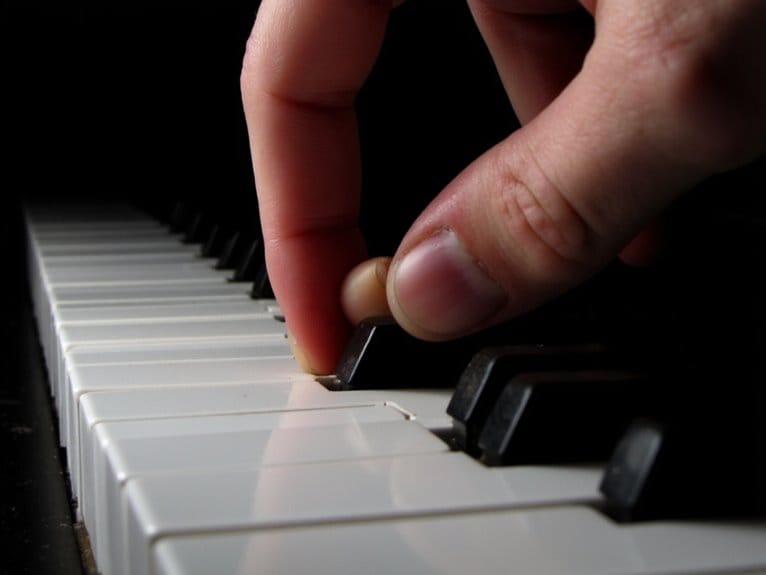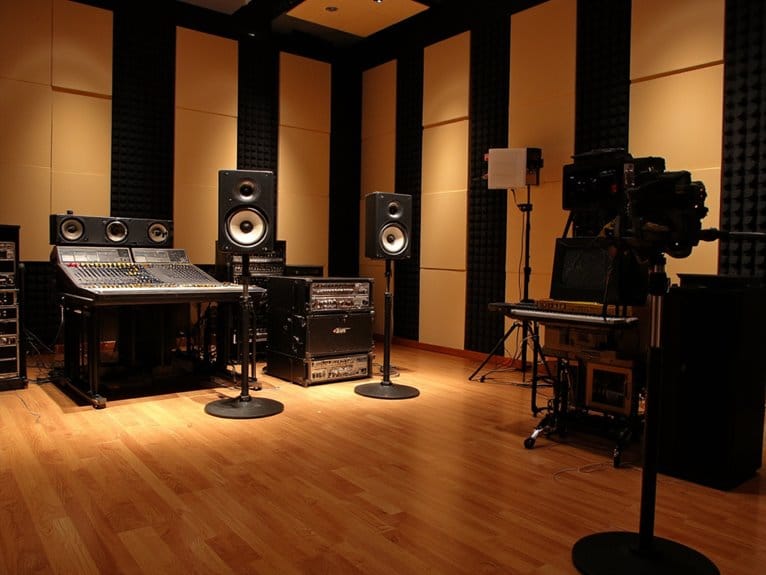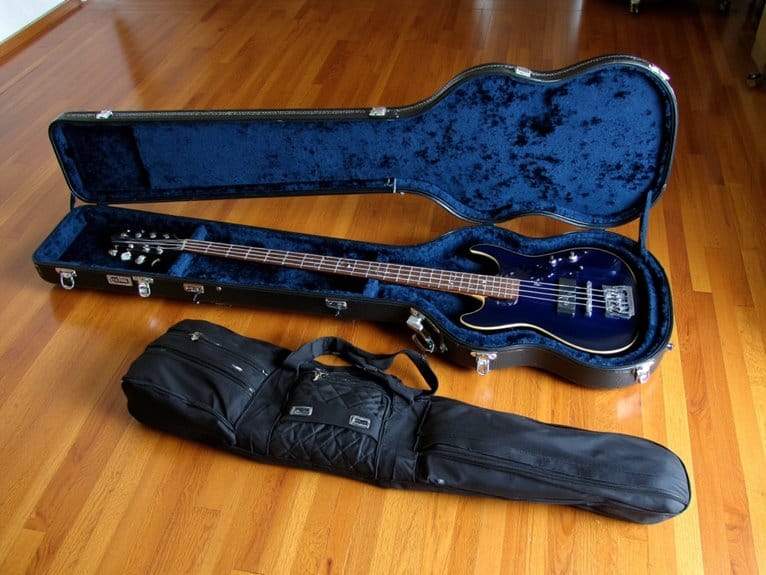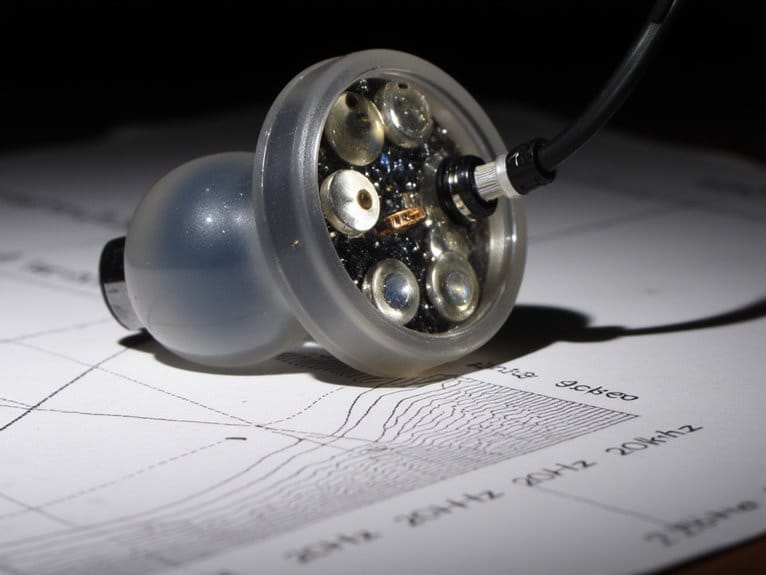Understanding MIDI Velocity and Aftertouch
MIDI velocity transforms your key presses into numerical data from 0-127, controlling not just volume but also brightness, attack characteristics, and timbral complexity through sophisticated parameter modulation. When you strike keys harder, you’re sending higher velocity values that can expose filter cutoffs, increase FM depth, and create brighter overtones that mimic acoustic instruments. Aftertouch adds continuous expression by detecting pressure after the initial key strike, with channel aftertouch affecting all notes simultaneously while polyphonic aftertouch allows individual key control. Understanding these dynamics reveals the full expressive potential of your digital instruments.
We are supported by our audience. When you purchase through links on our site, we may earn an affiliate commission, at no extra cost for you. Learn more.
Notable Insights
- MIDI velocity ranges from 0-127 and controls dynamics, timbre, brightness, and attack characteristics beyond simple volume adjustments.
- Velocity mapping allows sophisticated sound parameter control including filter cutoff, envelope times, and LFO depths for realistic instrument emulation.
- Channel aftertouch affects all notes simultaneously while polyphonic aftertouch enables individual key pressure control for enhanced expression.
- Modern MIDI 2.0 expands from 7-bit to 16-bit resolution, providing over 16,000 velocity values for greater dynamic nuance.
- Velocity data influences harmonic content and brightness, mimicking acoustic instruments where increased force produces brighter overtones naturally.
What Is MIDI Velocity and How Does It Work?
The heartbeat of digital music expression, MIDI velocity transforms the simple act of pressing a key into a nuanced performance parameter that I’ve found makes all the difference between lifeless sequences and truly musical phrases.
When you press a key, your MIDI controller measures how fast or hard you struck it, converting that physical gesture into numerical data ranging from 0 to 127. This velocity information doesn’t just control volume—it shapes timbre, brightness, and attack characteristics, making your virtual piano sound brighter with harder strikes or your synth leads cut through the mix with aggressive playing. Before MIDI technology emerged in the early 1980s, electronic instruments struggled to capture this dynamic expression that acoustic instruments naturally provided.
Beyond basic volume control, velocity can trigger velocity layering techniques that activate entirely different samples or sound layers depending on how hard you play, creating incredibly realistic instrument emulations. Modern audio interfaces that capture MIDI data typically operate at 24-bit resolution to ensure these subtle velocity nuances are preserved with crystal clear accuracy. Understanding velocity sensitivity settings and practicing various MIDI expression techniques will elevate your performances from mechanical to musical.
The Evolution of Dynamic Expression in Electronic Music
When I first started exploring electronic music in the late ’80s, I couldn’t understand why my digital piano sounded so mechanical compared to my acoustic upright—a frustration that perfectly illustrates how far we’ve come in dynamic expression technology.
Early electronic instruments offered limited expressive capabilities, lacking the velocity sensitivity that’s now standard. MIDI’s introduction transformed this landscape, providing 0-127 velocity values that dramatically expanded dynamic range possibilities.
| Era | Technology | Dynamic Range |
|---|---|---|
| 1970s | Mechanical contacts | Fixed velocity |
| 1980s | Basic MIDI velocity | 0-127 values |
| 1990s | Channel aftertouch | Continuous pressure |
| 2000s | Polyphonic aftertouch | Per-key control |
| 2010s+ | High-resolution MIDI | 16,000+ values |
Modern Hall effect sensors now detect continuous pressure changes throughout key travel, enabling simultaneous velocity and aftertouch detection that brings electronic instruments closer to acoustic responsiveness. Contemporary designs often utilize neodymium magnets paired with these sensors to eliminate mechanical contacts entirely, improving both reliability and sensitivity in professional instruments.
How Synthesizers Interpret and Map Velocity Data
You’ll discover that modern synthesizers offer far more sophisticated velocity mapping than simple volume control, allowing you to create custom response curves that transform how your playing dynamics translate into sound.
Beyond the standard velocity-to-amplitude relationship, you can route velocity data to modulate filter cutoff frequencies, LFO depths, envelope attack times, and dozens of other synthesis parameters, fundamentally turning your keyboard’s touch sensitivity into a multi-dimensional expression controller.
I’ve found that experimenting with these custom mappings, particularly when you assign velocity to unexpected parameters like reverb send levels or oscillator detuning, can dramatically reshape your instrument’s character and responsiveness.
Custom Velocity Mapping Functions
Behind every synthesizer’s response to your playing lies a sophisticated translation system that converts MIDI velocity values into actual sound parameters, and frankly, the variety of approaches manufacturers take can be surprising.
Modern synthesizers offer extensive custom mapping capabilities that go far beyond simple amplitude control, allowing you to shape how velocity modulation affects everything from filter cutoff to envelope decay times. You’ll find graphical curve editors in software synths like essential, where you can draw complex response curves, select from preset options like logarithmic or square mappings, or even assign velocity to unconventional parameters like pitch for creative effects.
These customizable functions transform velocity from a basic volume control into a sophisticated expressive tool. Hardware synthesizers like the Synth Multi-engine feature polyphonic aftertouch across their RGB-backlit pads, enabling even more nuanced velocity response and expressive control over multiple voices simultaneously.
Parameter Modulation Beyond Volume
While custom velocity curves give you control over how your keyboard responds, the real magic happens when synthesizers use that velocity data to modulate parameters far beyond simple volume changes, and I’ve found that most players barely scratch the surface of these possibilities.
Modern synthesizers employ non linear scaling to create natural, expressive modulation across multiple parameters. You’ll discover that velocity can control filter cutoff frequency, envelope rates, and even oscillator pitch, transforming your playing dynamics into complex timbral variations.
| Parameter | Low Velocity Effect | High Velocity Effect |
|---|---|---|
| Filter Cutoff | Darker, muffled tone | Brighter, harmonically rich |
| Envelope Rate | Slower attack/decay | Faster, more aggressive |
| Distortion Amount | Clean, pristine sound | Gritty, overdriven character |
This approach mimics acoustic instruments, where harder strikes naturally produce brighter, more complex harmonics than gentle touches. Similar to how podcasters use cardioid patterns to isolate their vocal performance from background noise, synthesizers isolate velocity data to create focused parameter modulation that enhances musical expression.
The Relationship Between Velocity, Dynamics, and Timbre
When you press a key on your MIDI controller, you’re not just triggering a simple on/off switch—you’re sending velocity data that modern synthesizers use to control far more than just volume, including brightness, attack characteristics, and complex timbral variations that mirror how acoustic instruments naturally respond to playing intensity. This dynamic responsiveness allows for a more expressive performance, giving musicians the ability to shape their sound in real time. As a result, choosing the best Ableton controller can significantly enhance this interaction, providing more intuitive controls and a layout that suits your style. With dedicated pads, knobs, and faders, the right controller can unlock the full potential of your MIDI input, enabling you to create stunning soundscapes that resonate with emotional depth.
I’ve found that the most convincing digital piano sounds come from instruments that use velocity to seamlessly cross-fade between multiple samples of the same note recorded at different intensities, recreating the hammer-to-string dynamics that make acoustic pianos so expressive.
Your velocity input becomes a powerful tool for modulating parameters like filter cutoff, FM depth, and envelope shapes, transforming what could be static, lifeless tones into dynamic, breathing sounds that respond naturally to your playing style.
Modern MIDI keyboards with velocity-sensitive keys provide the foundation for expressive performance, allowing players to achieve realistic dynamics whether working with software instruments or hardware synthesizers.
Velocity Beyond Volume Control
Most people think MIDI velocity simply controls how loud a note sounds, but I’ve discovered through years of programming synthesizers that velocity actually functions as a sophisticated, multidimensional controller that simultaneously shapes both dynamics and timbre in ways that mirror real acoustic instruments.
When you strike a key harder, you’re not just making it louder—you’re fundamentally altering the sound’s character through velocity sensitivity. This mimics how acoustic instruments naturally brighten and change color with increased playing force.
Modern synthesizers use velocity to control multiple parameters simultaneously:
- Filter cutoff frequency opens up for brighter tones at higher velocities
- Sample selection switches between different recordings across velocity ranges
- Modulation depth in FM synthesis creates varying harmonic complexity
Dynamic layering techniques crossfade between these velocity zones, creating seamless timbral shifts that make virtual instruments sound remarkably realistic and expressive.
Acoustic Instrument Mimicry
This sophisticated velocity mapping becomes particularly fascinating when you examine how closely it mirrors the natural physics of acoustic instruments, where the relationship between playing force and sound character isn’t just programmed—it’s built into the very structure of how sound waves are produced.
When you strike a piano key harder, you’re not just increasing volume—you’re fundamentally altering the harmonic content as the hammer impacts strings with greater force, creating brighter overtones and more complex timbral variations.
This natural phenomenon explains why synthesizers like the Yamaha DX7 emphasize timbral modulation over simple amplitude changes, using velocity to control FM modulation depth rather than just loudness.
Such acoustic dynamics create the foundation for expressive modulation that makes digital instruments feel genuinely responsive to your touch.
Timbral Parameter Modulation
Beyond simple volume control, MIDI velocity serves as a sophisticated gateway to timbral manipulation, fundamentally altering the character and color of synthesized sounds in ways that mirror—and sometimes exceed—the natural behavior of acoustic instruments.
When you adjust velocity sensitivity settings, you’re basically programming how your synthesizer responds to playing intensity, controlling multiple sound parameters simultaneously rather than just amplitude. This creates remarkable timbral diversity across your velocity range:
- Filter cutoff modulation brightens or darkens sounds based on how hard you strike keys
- Harmonic content adjustment adds or removes overtones for richer, more complex timbres
- Sample layer switching triggers entirely different recordings at various velocity thresholds
Modern synthesizers map velocity to complex parameter matrices, allowing softer touches to produce muted, darker tones while aggressive playing yields brilliant, harmonically rich sounds that feel genuinely expressive.
MIDI Aftertouch: Adding Continuous Expression to Your Performance
While velocity captures the initial impact of your keystrokes, aftertouch reveals a completely different dimension of musical expression by responding to the continuous pressure you apply after striking a key.
You’ll encounter two distinct types: channel aftertouch, which sends a single pressure value affecting all notes simultaneously, and polyphonic aftertouch, which provides individual pressure control for each key you’re pressing.
Channel aftertouch is more common since it’s simpler to implement, while polyphonic aftertouch offers superior expressiveness but requires premium instruments with advanced capabilities.
Technical Standards and Implementation Across MIDI Versions
When you immerse yourself in MIDI’s technical specifications, you’ll discover that velocity data operates within carefully defined parameters that have evolved considerably across different MIDI versions.
I’ve observed how MIDI standards transformed velocity handling from the original 7-bit resolution to MIDI 2.0’s impressive 16-bit capability, fundamentally changing performance nuances.
Implementation strategies vary dramatically across devices:
Device implementation approaches differ significantly, with each manufacturer developing distinct methodologies for processing and responding to velocity information across their product ecosystems.
- Hardware synthesizers interpret velocity through different algorithms, creating unique velocity variation responses
- Software instruments often provide customizable velocity curves for tailored expression
- Modern DAWs include sophisticated velocity mapping tools for enhanced control
The technical transmission remains consistent—velocity travels as part of the Note On message through MIDI’s 31.25 Kbaud serial interface. The reliability of this transmission is crucial for musicians and producers who depend on accurate timing for their compositions. In addition to understanding the technical aspects, it is also important to familiarize oneself with different devices and connections involved; midi cable types explained can help clarify which options are best suited for specific setups. This knowledge enhances the effectiveness of MIDI in both studio and live performance environments.
However, downstream interpretation differs wildly, with some devices using velocity for amplitude scaling while others trigger sample switching or filter modulation, making each implementation uniquely expressive.
Frequently Asked Questions
Can I Use Velocity Data to Control Effects Like Reverb or Delay?
You can absolutely use velocity modulation to control reverb and delay parameters. By mapping velocity data to effect sends, you’ll create dynamic effects that respond to your playing intensity, making soft notes dry and hard hits wetter with more ambience.
Do All MIDI Keyboards Have the Same Velocity Sensitivity Curve?
No, you’ll find velocity response variations across different MIDI keyboards since keyboard manufacturer differences mean each implements their own sensitivity curves, with some offering selectable options while others use fixed responses.
How Do I Fix Uneven Velocity Response on My MIDI Controller?
You can fix uneven velocity response through MIDI calibration techniques like adjusting velocity curves in your DAW, using controller sensitivity adjustments in manufacturer software, or applying real-time MIDI velocity normalization plugins.
Can Velocity Be Edited After Recording MIDI Notes in My DAW?
Yes, you can edit velocity after recording through your DAW’s MIDI editing interface. Most DAWs let you make velocity adjustments by dragging bars, entering values manually, or using batch processing tools for precise control.
Why Do Some Cheap Keyboards Have Poor Velocity Detection?
Cheap keyboards use inferior keyboard materials like rubber domes and basic sensor technology that can’t accurately measure your key strike timing. You’ll get inconsistent velocity detection because manufacturers cut costs on precision components.
On a final note
You’ve now got a solid foundation in velocity and aftertouch, two fundamental controllers that’ll transform how you approach musical expression in your DAW. Whether you’re programming realistic drum patterns, crafting dynamic synth leads, or adding subtle performance nuances through aftertouch modulation, these tools give you precise control over dynamics and timbre that separates amateur-sounding tracks from professional productions.





